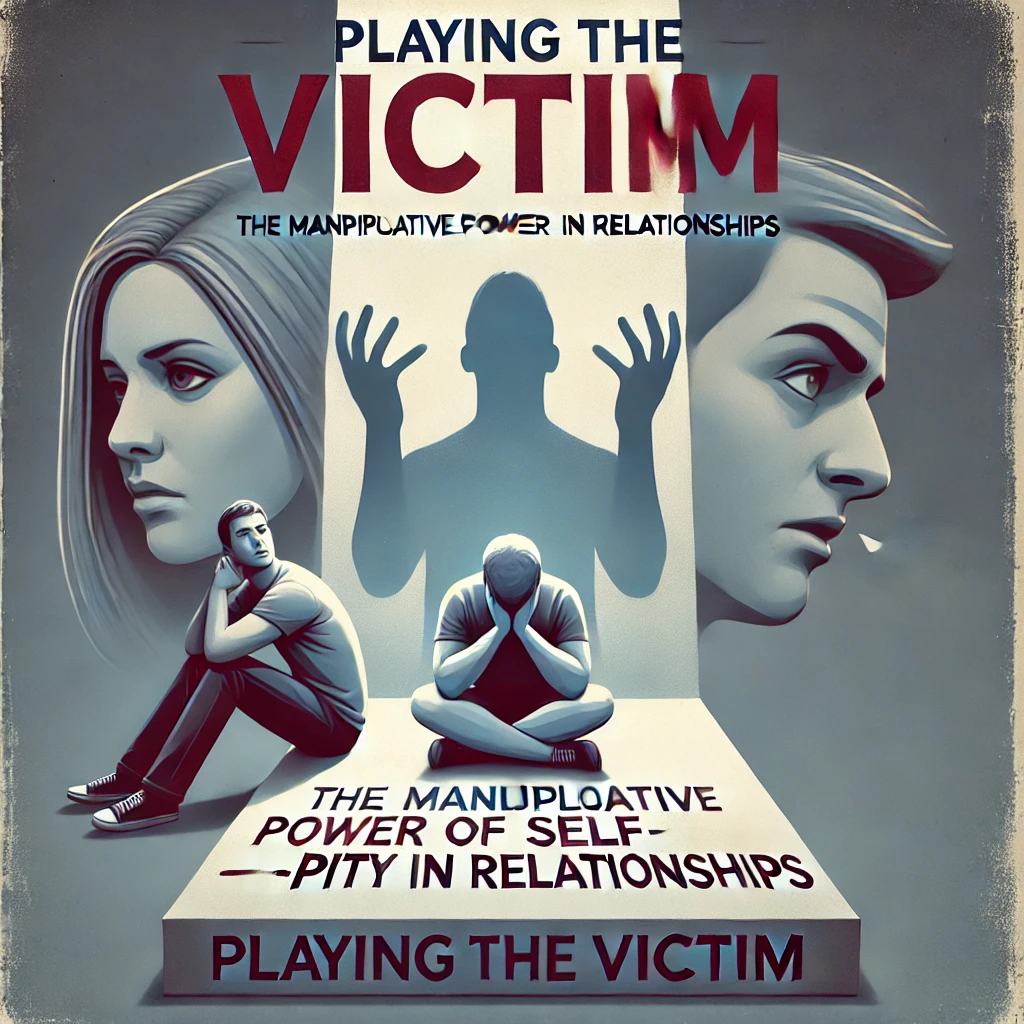In any relationship, we all experience moments of frustration, disappointment, or hurt. But what happens when one partner consistently positions themselves as the victim—regardless of the situation? This is the heart of a classic manipulation tactic known as playing the victim. It’s a strategy where someone exaggerates or fabricates their sense of being wronged to gain sympathy, avoid responsibility, or deflect blame. While playing the victim might seem like a harmless way to win an argument or evoke compassion, over time, it can create toxic patterns of manipulation and emotional control.
In “Mastering Him: The Secret Art of Gentle Control in Relationships”, Chapter 8 dives deep into playing the victim, examining how this tactic can subtly erode trust and balance in relationships. The victim role allows the manipulator to sidestep accountability, leaving the other partner feeling guilty, confused, and constantly trying to “make up” for something they didn’t do wrong. It’s a powerful emotional weapon—one that can easily tip the scales of control in favor of the person using it.
This blog will explore what playing the victim looks like, why it works, and how to recognize when it’s happening in your relationship. By the end, you’ll understand how this tactic operates and how to respond in a way that protects your emotional well-being.
What Is “Playing the Victim”?
Playing the victim occurs when someone consistently positions themselves as the wronged party, regardless of the actual circumstances. It’s a form of emotional manipulation where the person exaggerates their own suffering or unfair treatment to gain sympathy, shift the focus away from their own behavior, or deflect blame. The victim role is a powerful one because it taps into the natural human instinct to nurture and protect those who are hurting.
In relationships, playing the victim often leads to an imbalance of power. The person cast as the “victim” controls the narrative, making the other partner feel guilty or responsible for their unhappiness. Over time, this can lead to a dynamic where the partner constantly feels like they have to cater to the victim’s needs, even if they haven’t done anything wrong.
Why Does Playing the Victim Work?
Playing the victim works because it leverages empathy, guilt, and responsibility. Most people want to help and support their partner, especially when they believe their partner has been hurt or wronged. By positioning themselves as the victim, the manipulator taps into this desire to help and shifts the emotional responsibility onto their partner.
The victim creates an environment where the other person feels the need to “fix” the situation or avoid further hurting their partner. This emotional pressure can lead to behavior changes—such as giving in to demands, apologizing unnecessarily, or constantly walking on eggshells to avoid conflict.
Real-Life Examples of Playing the Victim in Relationships
Let’s explore some real-life examples of how playing the victim might show up in relationships. These scenarios will help you recognize this manipulation tactic and understand how it operates.
Example 1: The Guilt Trip Over Minor Issues
Your partner often uses guilt as a way to gain sympathy, even when the issue is small or insignificant. By framing themselves as the victim, they make you feel like you’ve wronged them—forcing you to apologize or make up for it.
Playing the Victim in Action:
You forget to respond to a text because you were busy at work, and when you finally get back to them, your partner responds with, “I guess I’m not important enough to get a quick message back. I don’t know why I even bother.” This small oversight is transformed into a major emotional grievance, making you feel guilty for something that wasn’t intended as a slight.
Why It Works:
By framing the situation in this way, your partner positions themselves as the one who’s been hurt, shifting the responsibility onto you to make it right. You might apologize or go out of your way to make it up to them, even though the original issue was minor.
Example 2: Blaming You for Their Feelings
A common form of victim-playing involves blaming you for their emotional state, regardless of the actual cause. Your partner makes it seem like your actions are the sole reason for their unhappiness or stress, creating a sense of responsibility for their well-being.
Playing the Victim in Action:
Your partner is stressed out from work, but instead of discussing it or finding healthy ways to cope, they say, “I wouldn’t be so stressed all the time if you helped out more around the house.” Suddenly, their personal stress is framed as your fault, even though it has nothing to do with the actual situation.
Why It Works:
By blaming their emotional state on you, your partner makes you feel responsible for their happiness. This tactic creates a sense of guilt, making you more likely to adjust your behavior to try to alleviate their stress—whether or not you’re truly at fault.
Example 3: Avoiding Accountability
Playing the victim is often a way for someone to avoid taking responsibility for their actions. By framing themselves as the victim, they can deflect blame and shift the focus away from their own behavior.
Playing the Victim in Action:
Your partner lashes out during an argument and says hurtful things, but when you try to address it later, they respond with, “You know I’ve been under so much pressure lately. I’m doing my best, and you always make me feel worse when I’m already struggling.” Instead of acknowledging their hurtful behavior, they position themselves as the one who’s been wronged, making you feel bad for bringing it up in the first place.
Why It Works:
By shifting the focus to their struggles, your partner avoids accountability for their actions. You end up feeling guilty for even addressing the issue, and the original problem goes unresolved. Over time, this can lead to a dynamic where you avoid confronting your partner to keep the peace.
Example 4: Using Past Hurts as Emotional Leverage
In some cases, playing the victim involves bringing up past hurts or trauma as a way to manipulate current situations. Your partner uses their history of being wronged to gain sympathy and avoid responsibility for their current behavior.
Playing the Victim in Action:
You and your partner are having a disagreement about how to spend the holidays. Instead of discussing the issue, your partner says, “You know I’ve never felt appreciated by my family. Why can’t you just understand how hard this time of year is for me?” Suddenly, the focus shifts from the actual discussion to their past hurts, making it difficult for you to address the current issue.
Why It Works:
By bringing up past trauma, your partner shifts the emotional burden onto you, making it seem like you’re being insensitive or unsupportive. This tactic makes it hard for you to push back or stand your ground without feeling like you’re adding to their pain.
How to Recognize Playing the Victim in Relationships
If you suspect that your partner is playing the victim in your relationship, here are some signs to watch for:
- Frequent guilt trips: Your partner regularly makes you feel guilty for minor issues or things that aren’t your fault.
- Blaming you for their emotions: Your partner often makes it seem like their emotional state is entirely your responsibility.
- Avoiding accountability: When you try to address issues, your partner shifts the focus to their own struggles or makes you feel guilty for bringing it up.
- Using past trauma as leverage: Your partner frequently brings up past hurts to gain sympathy or avoid discussing current problems.
How to Respond When Someone Plays the Victim
If you’re dealing with someone who consistently plays the victim, it’s important to set boundaries and protect your emotional well-being. Here’s how to respond:
- Acknowledge Their Feelings, But Stay Firm: It’s important to validate your partner’s feelings, but don’t allow yourself to be manipulated. For example, “I understand that you’re feeling hurt, but I need us to address this issue directly.”
- Refocus the Conversation: When your partner tries to shift the blame or guilt onto you, gently guide the conversation back to the original issue. “I hear that you’re stressed, but I’d still like to talk about what happened during our argument.”
- Don’t Over-Apologize: If your partner is playing the victim, it’s easy to fall into the trap of over-apologizing to keep the peace. However, this only reinforces the behavior. Apologize if necessary, but don’t take responsibility for things that aren’t your fault.
- Set Boundaries: Let your partner know that while you care about their feelings, you’re not willing to take on responsibility for their emotional state. “I can’t be responsible for your happiness, but I’m here to support you in figuring out how to manage your stress.”
Q&A
- Q: What does it mean when someone “plays the victim” in a relationship?
- A: Playing the victim in a relationship involves one partner consistently positioning themselves as the wronged party to gain sympathy or avoid responsibility.
- Q: Why do people play the victim in relationships?
- A: People may play the victim to gain sympathy, control the narrative, and deflect blame onto their partner.
- Q: How can I tell if my partner is playing the victim?
- A: Signs include frequent guilt trips, avoiding accountability, blaming you for their emotions, and using past trauma as leverage.
- Q: How does playing the victim manipulate a partner?
- A: Playing the victim shifts responsibility and guilt onto the other person, leading them to cater to the victim’s needs and feelings.
- Q: How should I respond if my partner always plays the victim?
- A: Respond by setting boundaries, acknowledging their feelings without over-apologizing, and refocusing on the original issue.
- Q: Why do some people always act like the victim in a relationship?
- A: Acting like the victim can be a learned behavior or coping mechanism to maintain control and avoid facing their own actions.
- Q: Is playing the victim a form of emotional abuse?
- A: Yes, it can be a form of emotional manipulation or abuse, as it puts emotional pressure on the partner to feel guilty or responsible.
- Q: Can playing the victim damage a relationship?
- A: Yes, it can create resentment, erode trust, and create an unbalanced dynamic where one partner is constantly seeking validation.
- Q: What are examples of playing the victim in relationships?
- A: Examples include guilt-tripping over small issues, blaming their partner for their emotions, or bringing up past hurts to gain sympathy.
- Q: How can I stop my partner from playing the victim without causing conflict?
- A: Gently set boundaries, validate their feelings without taking blame, and encourage open and honest communication about underlying issues.
Ready to Master the Art of Influence in Your Relationship?
If you’re ready to dive deeper into the world of subtle manipulation tactics like playing the victim and learn how to navigate these emotional dynamics, then “Mastering Him: The Secret Art of Gentle Control in Relationships” is the book for you. In Chapter 8, you’ll discover how to identify manipulative behaviors, respond effectively, and create a relationship dynamic built on trust, accountability, and respect.
This book isn’t just about manipulation—it’s about understanding the psychological tactics that can shape your relationship and learning how to protect yourself while fostering a healthier, more balanced connection. Get your copy today and start mastering the art of subtle control in your relationship—because understanding influence is the key to lasting harmony and connection.
Read more about the book: https://developmentpill.com/mastering-him-the-secret-art-of-gentle-control-in-relationships-a-guide-to-influence-hell-never-see-coming/
Book Link: https://www.amazon.com/dp/B0DKKGLZQ9
Book Link UK: https://www.amazon.co.uk/dp/B0DKKGLZQ9



